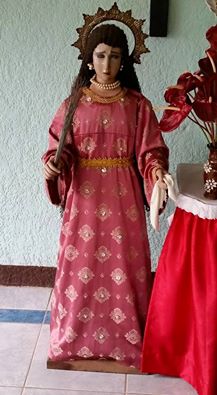
Photo copyright 2015 Andrew Chesnut,
used with permission

Photo copyright 2015 Andrew Chesnut,
used with permission
This statue is a religious depiction of the daughter of Herodias. It represents "the daughter of Herodias" in Holy Week processions in Argao, in the Philippines.
For somewhat unclear reasons the bibical "daughter of Herodias" is occasionally confused with the biblical "Salome of the tomb" or "Salome the disciple" who in Mark 16:1 was among the women who went to the tomb of Jesus.
In the Orthodox churches, the biblical "Salome of the tomb" or "Salome the disciple" is known as "Saint Salome the Myrrh-bearer." Saint Salome was the mother of the Apostles James and John, the wife of Zebedee, and was the Virgin Mary's step-daughter. Saint Salome's feast day is August 3. The Orthodox churches also commemorate seven women on the "Sunday of the Holy Myrrh-bearing Women" aka the "Synaxarion" which is held on the third Sunday of Easter/Pascha. These seven myrrh bearing women include Salome, along with Mary Magdalene, Mary, another Mary, Martha, Joanna, and Susanna.
Many biblical scholars state that the biblical "Salome of the tomb" or "Salome the disciple" is not to be confused with the daughter of Herodias--who is never called Salome in the bible. That name for the daughter of Herodias comes from a historical account by Flavius Josephus.
This figure is crowned by a saintly halo. However, if this statue is supposed to represent "Salome of the tomb" or "Salome the disciple," why is she not holding a container of myrrh, as is typical in Orthodox iconography?
The small white cloth in the figure's left hand is a handkerchief. The stick-like item in her right hand is a broom. The face of the figure seems sorrowful or remorseful.
A handkerchief? A broom? In Italian folklore, Erodiade (Herodias or her daughter) was supposed to fly through the air--sometimes on a broom along with witches--on the night of June 23, the night before the Feast of Saint John. Also in Italian folklore, the daughter of Herodias is very remorseful over the death of the saint, John the Baptist, and her tears are said to be the dew on the ground on the morning of June 24. Apparently, the figure carries a handkerchief because she has been weeping.
As Andrew Chestnut indicated, this figure does seem to be the daughter of Herodias. There is often much overlap between Italian and Spanish Catholic culture.
copyright 2015 Myth Woodling
Erodiade painting
Erodiade Regina
The Dance of Herodias's Daughter
Aradia Goddess home page